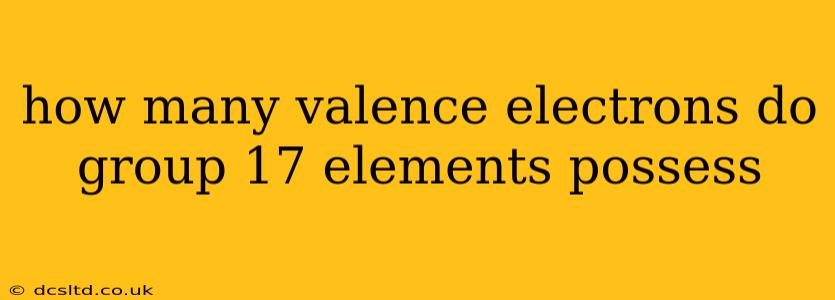Group 17 elements, also known as the halogens, are a fascinating group on the periodic table, known for their high reactivity. Understanding their electronic structure is key to comprehending their chemical behavior. The simple answer is: Group 17 elements possess seven valence electrons.
Let's delve deeper into why this is the case and explore some related concepts.
What are Valence Electrons?
Before we get into the specifics of Group 17, let's define valence electrons. Valence electrons are the electrons located in the outermost shell (energy level) of an atom. These electrons are the ones involved in chemical bonding, determining an element's reactivity and the types of compounds it can form.
Why Do Group 17 Elements Have Seven Valence Electrons?
The periodic table is organized in a way that reflects the electronic configuration of elements. Group 17 elements are found in the p-block of the periodic table. Their electron configuration always ends with a p⁵ subshell. This means they have a full s subshell (containing 2 electrons) and five electrons in their p subshell. Adding those together (2 + 5 = 7), we arrive at the seven valence electrons.
Here's a breakdown for a few examples:
- Fluorine (F): 1s²2s²2p⁵ (7 valence electrons)
- Chlorine (Cl): 1s²2s²2p⁶3s²3p⁵ (7 valence electrons)
- Bromine (Br): 1s²2s²2p⁶3s²3p⁶4s²3d¹⁰4p⁵ (7 valence electrons)
- Iodine (I): 1s²2s²2p⁶3s²3p⁶4s²3d¹⁰4p⁶5s²4d¹⁰5p⁵ (7 valence electrons)
- Astatine (At): Similar pattern, ending in a 6p⁵ subshell (7 valence electrons)
Notice the pattern: regardless of the number of inner electron shells, they always finish with seven electrons in their outermost shell.
How Does This Affect Their Reactivity?
Having seven valence electrons means halogens are one electron short of a stable octet (eight electrons in the outermost shell). This makes them highly reactive. They readily gain an electron to achieve a stable electron configuration, forming negatively charged ions called halides (e.g., F⁻, Cl⁻, Br⁻, I⁻). This tendency to gain an electron explains why they readily react with metals, which tend to lose electrons.
What are some common compounds formed by Group 17 elements?
Because of their high reactivity, Group 17 elements form a wide variety of compounds. Some common examples include:
- Sodium chloride (NaCl): Table salt, formed from the reaction of sodium (a Group 1 metal) and chlorine.
- Hydrogen halides (HF, HCl, HBr, HI): These are strong acids when dissolved in water.
- Organic halides: These compounds contain carbon-halogen bonds and are used in various applications, including refrigerants and solvents.
What are some other properties of group 17 elements?
What is the trend in electronegativity in Group 17?
Electronegativity increases as you go up the group. Fluorine is the most electronegative element.
What is the trend in atomic radius in Group 17?
Atomic radius increases as you go down the group. This is because there are more electron shells.
Are halogens diatomic?
Yes, halogens exist as diatomic molecules (e.g., F₂, Cl₂, Br₂, I₂) in their elemental form. This means they exist as pairs of atoms bonded together.
In conclusion, the key takeaway is that Group 17 elements, the halogens, possess seven valence electrons, a feature that drives their high reactivity and unique chemical properties. Understanding this fundamental aspect is crucial to comprehending their behavior and the role they play in various chemical processes.
